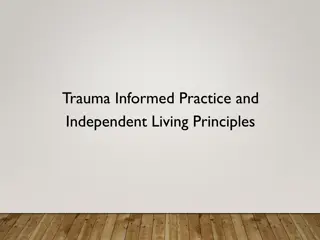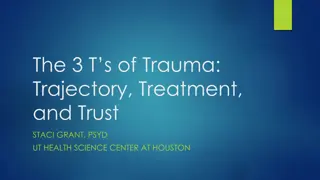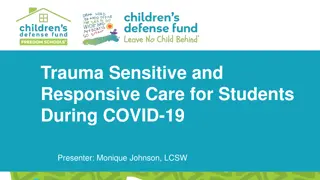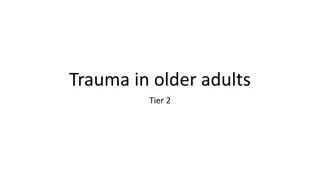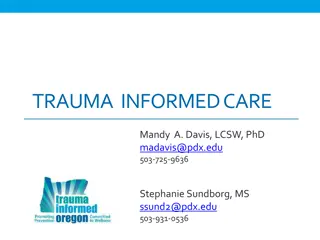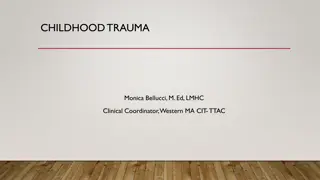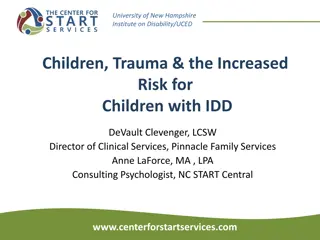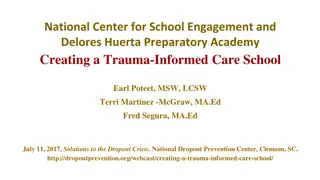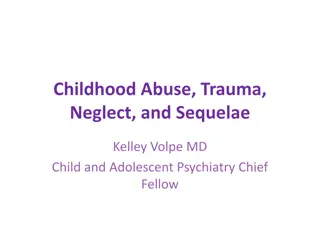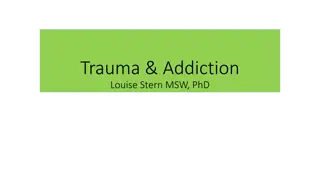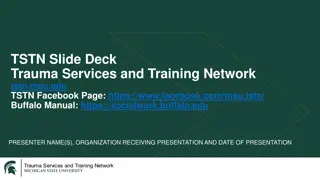Understanding Trauma Response and Treatment in the US
Trauma is prevalent in the US, with unresolved reactions affecting development and relationships. Effective treatment like Cognitive Processing Therapy (CPT) is vital for well-being. Sources of trauma include threats to the body, environmental events, and relational trauma. Responses to trauma vary from natural recovery to persistence of symptoms without treatment. Clinical symptoms of PTSD include intrusive thoughts, mood changes, and altered arousal levels. Addressing trauma through various theories and interventions is crucial for healing and well-being.
Download Presentation

Please find below an Image/Link to download the presentation.
The content on the website is provided AS IS for your information and personal use only. It may not be sold, licensed, or shared on other websites without obtaining consent from the author. Download presentation by click this link. If you encounter any issues during the download, it is possible that the publisher has removed the file from their server.
E N D
Presentation Transcript
Tex-CHIP Training Series Treating the Trauma Response
Discussion Overview Establish context through some quick facts about trauma in the US 1. Understand the Trauma Response 2. Describe 3 sources of trauma & types of responding 3. Discuss CPT as a manualized treatment 4. Demonstrate and Practice CPT modules 5.
Establishing Context Everyone has trauma 90% of US adults report being exposed to something notably traumatic Unresolved trauma reactions may be at the core of many developmental, relational, or clinical impairments To increase intrapersonal well-being and interpersonal functioning, meaningful and efficacious treatment is an imperative
Sources of Trauma Many possibilities, but also some distinct categories Threats to our body Environmental and disaster-related events Relational trauma
Types of Response Natural Recovery Response Traumatic Experience Recovery through treatment Persistence of Trauma Symptoms Compounding of symptoms through non-treatment
Clinical Symptoms of PTSD From the medical model perspective Exposure to traumatic material (direct or indirect) 1. Intrusion symptoms (flashbacks, nightmares, physio) 2. Negative changes in cognitions and mood 3. Alternations in arousal or activity level 4. Duration- ASD versus PTSD 5. Functional significance 6.
Clinical Symptoms of PTSD From a Wellness, Strength-based Perspective Alterations in positive emotions and happiness Decreased engagement with life activities Affected social relationships Disrupted perceptions of meaning and existential well- being Impediment to activities that promote sense of accomplishment
3 Sources of Trauma Response Biological dysregulation Behavioral explanations of trauma-focused interventions Behavioral theory Cognitive-emotional processing theory Cognitive explanations of trauma-focused interventions Social cognitive theory of PTSD
Establishing Context Research linking trauma exposure to delinquency is far-reaching and convincing. Small studies, specific studies, huge studies, over time Here s what we know: Delinquent youth almost always polyvictims People who are polyvictims tend to be aggressive & destructive Peer victims tend to emerge as those who get into physical fights, carry guns, and commit violent crimes Findings persist after considering age, gender, ethnicity, mental health diagnoses
Changes in the brain Neurocircuitry models make reference to some important brain areas Amygdala, medial prefrontal cortex and anterior cingulate, and hippocampus Activity in these areas is markedly different in kids with trauma history than without
Consequences: Low Road Versus High Road Anterior cingulate Objectively think about things High Road Prefrontal cortex Make decisions that inform feelings Neutral event Fight or flight response Amygdala Feared memories Low Road Traumatic memories are cued Hippocampus Reliving of previous experiences
Behavioral Conceptualizations Mowrer2 provided a framework for development and maintenance of fear responses Classical Conditining: Acquisition of Fear Response Classical Conditioning explains on onset/acquisition of fear response CS Car CR Fear of Riding in Cars UCS Hit by Drunk Driver Operant Conditioning maintains response through avoidance of fear provoking stimuli Operant Conditioning Response: Avoid Driving or Riding in Cars Aversive Stimilus Removed: Fear Reduced
Emotional Processing Theory Foa s3 practice-based theory integrated meaning into the learned response In response to traumatic experience, we develop meaning structures with stimulus and physiological responses Maintenance and recovery moderated by three factors: Degree of emotional engagement Quality of trauma-related cognitions Degree of narrative articulation
Social Cognitive Theory of PTSD Resick and colleagues4 depicted this model in the treatment of individuals with PTSD. Just-world thinking Hindsight bias Happily ever after thinking Assimilation Use traumatic event as proof of negative belief Related to safety, trust, power/control, esteem, and intimacy Avoidance of thinking about the event and problematic appraisals of event contribute to non-recovery. Over- accommodation Experience natural emotions Correct misappraisals associated with manufactured emotions Largely moderated through cognitive assimilation Keys to Recovery
Addressing Neurological, Behavioral, and Cognitive Components to Promote Recovery & Well-Being Cognitive Processing Therapy
Structure of Sessions 1: Overview of CPT and Reviewing Index Trauma 2 & 3: Finding Stuck Points 4 & 5: Processing the Index Event 6 & 7: Challenging Problematic Thinking 8 - 10: Challenging & Processing issues of Safety, Trust, Power/Control, and Esteem 11 & 12: Addressing Intimacy and Termination
Session 1 Overview of CPT and Reviewing Index Trauma GOALS: Client understands: How they got stuck in their recovery PTSD How CPT helps PROCEDURES: Set agenda Describe symptoms of PTSD Describe cognitive theory Discuss role of emotions in trauma recovery Briefly review the index trauma Describe overall course of therapy Give first assignment Check in on clients reactions to session
Session 2: Finding Stuck Points GOALS: PROCEDURES: Review Impact Statement Review PCL & PHQ Identifying stuck points Client reads Impact Statement Beginning self-monitoring activities Help identify and recognize connections between events, thoughts, and feelings Help differentiate between facts and thoughts Introduce ABC worksheet Further address Stuck Points Assign practice task Check in client reactions and process session





